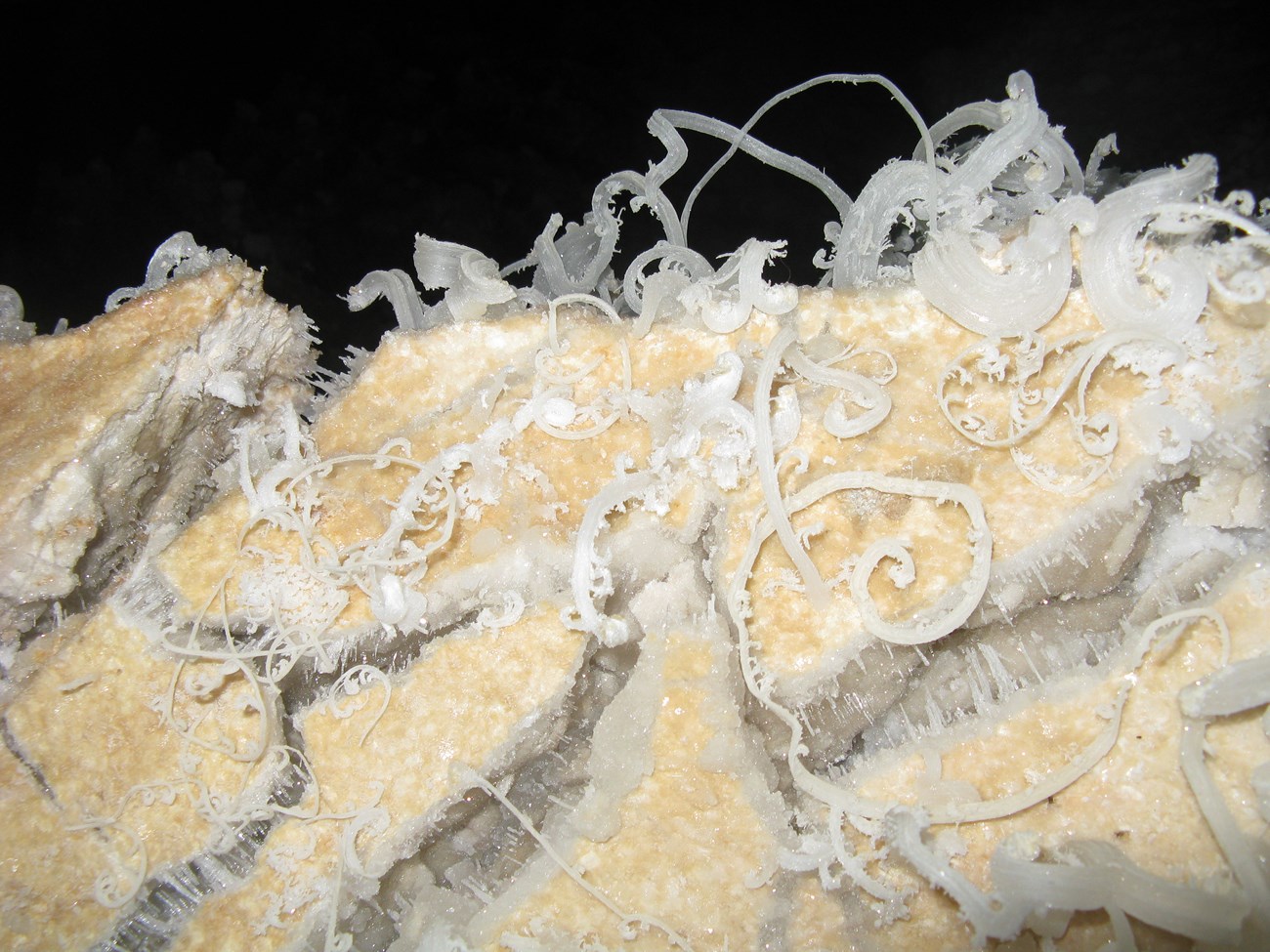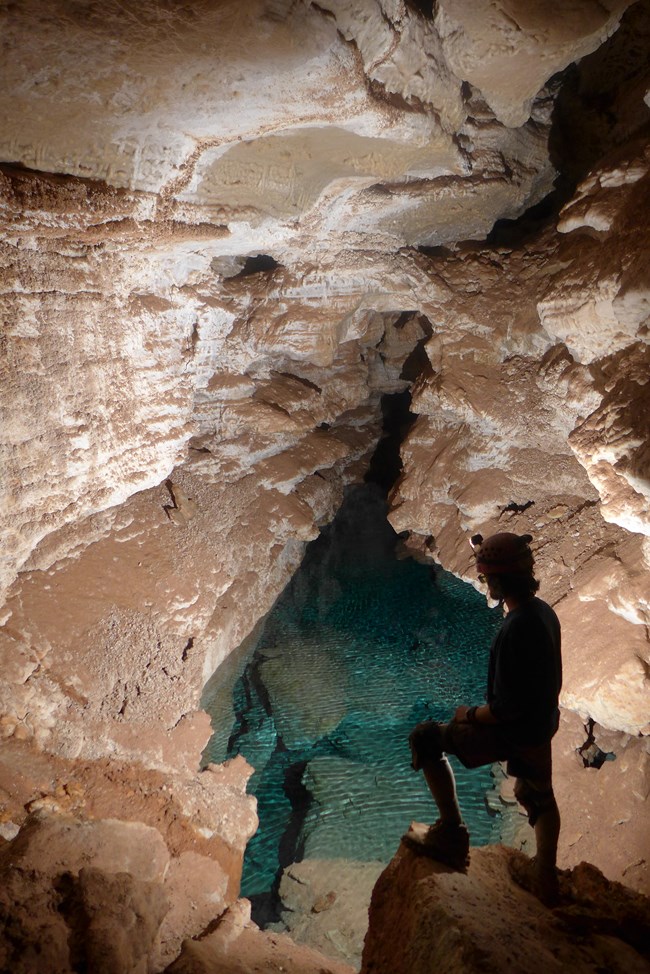Part of a series of articles titled Cave Week—Featured Articles.
Article
Cave Exploration in the National Parks

Photo by Joel Despain.
Why Do We Go Into Caves? To Explore.
Our national parks are routinely being enlarged. This is not through an act of Congress or a special authorization by the President. Rather the national parks keep growing because more is being discovered inside of national park caves. Far underground cavers are pushing the boundaries of many national park caves and the result is new, previously unexplored cave passages, rooms, streams and lakes, fossils and cave formations. In the last 18 months, three national park caves have celebrated milestones in their ever-growing lengths:
- Jewel Cave, at Jewel Cave National Monument, South Dakota (the third longest cave on Earth) is now more than 200 miles long;
- Wind Cave at Wind Cave National Park, South Dakota is now documented to be over 150 miles (7th longest in the world);
- Lechuguilla Cave at Carlsbad Caverns National Park, New Mexico also now exceeds 150 miles in known length (8th longest).
This is not the end of the story for any of these three caves. There is more to explore and to be found in these national park caves.
The Granddaddy of them all, the longest cave on Earth, Mammoth Cave in Mammoth Cave National Park, Kentucky is well over 400 miles in length. It sits under four counties and extends far beyond the park boundaries. It has grown in recent years by the connection of several much smaller nearby caves. By some odd quirk of history four of the ten longest caves on our planet are managed by the US National Park Service. None of these caves was anywhere near their known length at the time of park creation. Lechuguilla Cave was but a single room at the bottom of a pit.
Exploring the Big Caves

NPS photo.
Reaching the ends of the Earth underground is never easy in large cave systems. In Jewel and Lechuguilla Caves, cavers may need to camp for several days underground. Such expeditions require big packs to haul gear and food to support the crew. But the cave passages themselves are often tiny requiring very dense packing, very tough packs, and tenacious cavers to get the necessary gear through and to camp. Jewel Cave is particularly known for its tiny holes that lead to miles of large cave passages. The cavers have known where to go by following the airflow through these small tunnels and tubes. One section of long crawls is called the Miseries, while a section of even smaller holes is called the Mini-Miseries. Lechuguilla Cave has many roped vertical drops, that make for extra challenges and hard work. While on rope cavers “tether” or hang their large bags below themselves. Worn, the weight of the packs throws off ones' balance causing problems on rope.
Leave No Trace
Both caves are ancient deep systems that contain ancient and isolated communities of microbes. These rare and unique lifeforms may well harbor biological processes of benefit to people. Such as anti-microbial genetics. To protect the creatures and their habitat and the cave itself cavers stick to trails or designated routes. They use hoses and gravity-fed water systems to avoid water contaminating. And they implement important if inconvenient waste management practices. All waste both liquid and solid is removed by all cavers who camp overnight in Jewel Cave. In Lechuguilla liquid waste on trips longer than four days can be left in just three locations in the giant cave. All other waste is removed. Sometimes the packs are heavier going out of the cave than they were on the trip in.
Caver Life
The lack of packing space makes for odd foods. Most is dehydrated, cooked in camp and reconstituted with water from the cave. But getting the food there can require re-packaging to make it smaller, compressing it to fit and even grinding it get the maximum possible into a cave camp pack. Sometimes unsavory mixes occur – such as turkey tetrazzini with scrambled eggs. And with the decline in the size of the food comes a decline in palatability. But, cavers suffer through these annoyances to see and explore an amazing underground world.

Photo courtesy of Bill Frantz.
Not all cave discoveries happen in the giant caves of the National Park System. Lilburn Cave is the largest in California and lies within Kings Canyon National Park. But, compared to the big kids, it is small at only about 22 miles in length. Nevertheless, exploration of this cave also continues. The Cave Research Foundation operates in many national parks and in Kings Canyon they organize the exploration and research projects at Lilburn Cave. Lilburn is a three-dimensional maze. Cave passages above, to the side, below and around each other like a pile of spaghetti. Today most discoveries are small passages that are slowly add to the length of the cave. But the cavers continue to search and perhaps may again find passages that continue for hundreds of meters.
Research Community
Most of the cave explorers working in the National Parks are members of the National Speleological Society and other organizations such as the Cave Research Foundation, mentioned above. The groups work under Memorandums of Understanding with a given national park or through the Park Service scientific research program. The cavers train and practice important skills such as rope work, buy and even build their own specialized equipment, and often plan and organize research and exploration trips for months or years in advance. Caving is a serious and potentially dangerous undertaking. For some the chance to go and explore is why they go into caves.
Last updated: April 1, 2020
